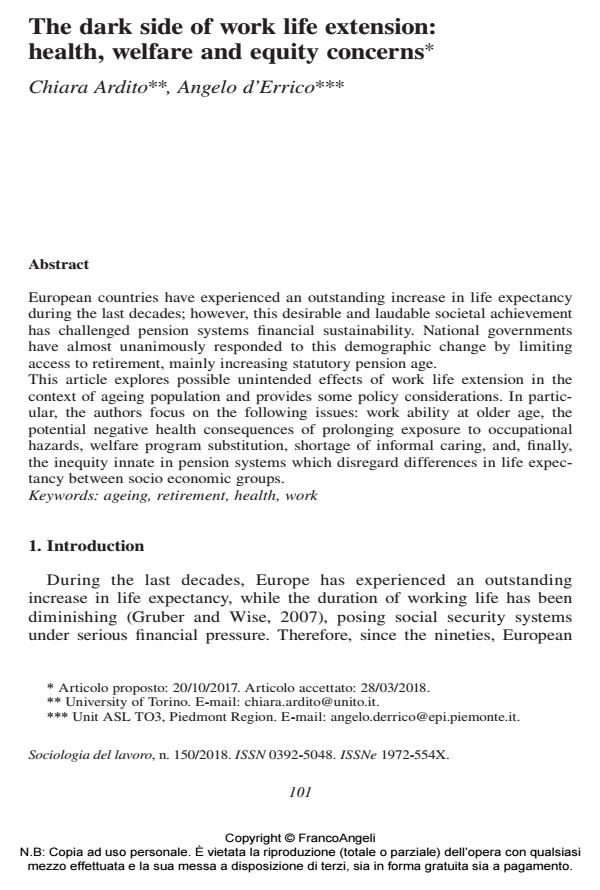The dark side of work life extension: health, welfare and equity concerns
Titolo Rivista SOCIOLOGIA DEL LAVORO
Autori/Curatori Chiara Ardito, Angelo d’Errico
Anno di pubblicazione 2018 Fascicolo 2018/150
Lingua Inglese Numero pagine 19 P. 101-119 Dimensione file 178 KB
DOI 10.3280/SL2018-150006
Il DOI è il codice a barre della proprietà intellettuale: per saperne di più
clicca qui
Qui sotto puoi vedere in anteprima la prima pagina di questo articolo.
Se questo articolo ti interessa, lo puoi acquistare (e scaricare in formato pdf) seguendo le facili indicazioni per acquistare il download credit. Acquista Download Credits per scaricare questo Articolo in formato PDF

FrancoAngeli è membro della Publishers International Linking Association, Inc (PILA)associazione indipendente e non profit per facilitare (attraverso i servizi tecnologici implementati da CrossRef.org) l’accesso degli studiosi ai contenuti digitali nelle pubblicazioni professionali e scientifiche
European countries have experienced an outstanding increase in life expectancy during the last decades; however, this desirable and laudable societal achievement has challenged pension systems financial sustainability. National governments have almost unanimously responded to this demographic change by limiting access to retirement, mainly increasing statutory pension age. This article explores possible unintended effects of work life extension in the context of ageing population and provides some policy considerations. In particular, the authors focus on the following issues: work ability at older age, the potential negative health consequences of prolonging exposure to occupational hazards, welfare program substitution, shortage of informal caring, and, finally, the inequity innate in pension systems which disregard differences in life expectancy between socio economic groups.
Negli ultimi decenni l’Europa ha conosciuto uno straordinario aumento dell’aspettativa di vita. Questo importante risultato ha tuttavia posto i sistemi previdenziali in serie difficoltà mettendone a rischio la sostenibilità finanziaria. I governi quasi all’unisono hanno risposto a questa sfida demografica inasprendo i requisiti pensionistici e innalzando l’età di pensionamento. Questo articolo esplora alcuni possibili effetti indesiderati di questo inatteso allungamento dell’orizzonte lavorativo. In particolare, gli autori si concentrano sulle seguenti questioni: ridotta capacità lavorativa in età anziana; possibili effetti negativi sulla salute dovuti alla prolungata esposizione a rischi occupazionali; sostituzione fra diversi meccanismi di assistenza sociale; riduzione del lavoro di cura informale; iniquità intrinseca al sistema pensionistico che non considera delle differenze nell’aspettativa di vita fra diversi gruppi sociali.
Parole chiave:Invecchiamento, pensionamento, salute, lavoro
- Early Retirement of Employees in Demanding Jobs: Evidence From a German Pension Reform Johannes Geyer, Svenja Lorenz, Thomas Zwick, Mona Bruns, in SSRN Electronic Journal /2021
DOI: 10.2139/ssrn.3979796 - Early retirement of employees in demanding jobs: Evidence from a German pension reform Thomas Zwick, Mona Bruns, Johannes Geyer, Svenja Lorenz, in The Journal of the Economics of Ageing 100387/2022 pp.100387
DOI: 10.1016/j.jeoa.2022.100387 - Handbook of Bioethical Decisions. Volume I Allen Porter, pp.247 (ISBN:978-3-031-29450-1)
- To Work or Not to Work? The Effect of Higher Pension Age on Cardiovascular Health Chiara Ardito, Roberto Leombruni, David Blane, Angelo d’Errico, in Industrial Relations: A Journal of Economy and Society /2020 pp.399
DOI: 10.1111/irel.12257 - Handbook of Socioeconomic Determinants of Occupational Health Hans Martin Hasselhorn, pp.105 (ISBN:978-3-030-31437-8)
- Older Workers and Labour Market Exclusion Processes Chiara Ardito, Maria Fleischmann, pp.161 (ISBN:978-3-031-11271-3)
- Working Conditions and Health Among Italian Ageing Workers Angelo d’Errico, Chiara Ardito, Roberto Leombruni, Fulvio Ricceri, Giuseppe Costa, Carlotta Sacerdote, Anna Odone, Andrea Amerio, Chiara Ardito, Greta Carioli, Giuseppe Costa, Angelo d’Errico, Dario Fontana, Beatrice Frascella, Giovanni Gaetti, Leandro Gentile, Vincenza Gianfredi, Roberto Leombruni, Anna Odone, Fulvio Ricceri, Carlotta Sacerdote, David Stuckler, Giacomo Pietro Vigezzi, Nicolas Zengarini, in Social Indicators Research /2022 pp.1043
DOI: 10.1007/s11205-021-02862-w - Use of wearable sensors to assess patterns of trunk flexion in young and old workers in the Metalworking Industry Micaela Porta, Pier Francesco Orrù, Massimiliano Pau, in Ergonomics /2021 pp.1543
DOI: 10.1080/00140139.2021.1948107 - Handbook of Socioeconomic Determinants of Occupational Health Hans Martin Hasselhorn, pp.1 (ISBN:978-3-030-05031-3)
- Early Retirement of Employees in Demanding Jobs: Evidence from a German Pension Reform Thomas Zwick, Svenja Lorenz, Johannes Geyer, Mona Bruns, in SSRN Electronic Journal /2021
DOI: 10.2139/ssrn.3985350
Chiara Ardito, Angelo d’Errico, The dark side of work life extension: health, welfare and equity concerns in "SOCIOLOGIA DEL LAVORO " 150/2018, pp 101-119, DOI: 10.3280/SL2018-150006